

Compact Muon Solenoid
LHC, CERN
| CMS-PAS-SMP-20-011 | ||
| Measurement and QCD analysis of double-differential inclusive jet cross sections in pp collisions at $\sqrt{s} = $ 13 TeV | ||
| CMS Collaboration | ||
| July 2021 | ||
| Abstract: A measurement of the double differential inclusive jet cross section as a function of the jet transverse momentum $p_{\mathrm{T}}$ and the absolute jet rapidity $|y|$ is presented. Data from LHC proton-proton collisions at $\sqrt{s}= $ 13 TeV, collected with the CMS detector with an integrated luminosity of 36.3 fb$^{-1}$ (33.5 fb$^{-1}$) are analysed. Jets are reconstructed using the anti-$k_{\mathrm{T}}$ clustering algorithm with size parameters of 0.4 (0.7) in a phase space region covering jet $p_{\mathrm{T}}$ from 97 GeV up to 3.1 TeV and jet absolute rapidity up to $|y|=$ 2.0. The measured jet cross section is corrected for detector effects and compared with the predictions from perturbative QCD. These measurements, together with the multi-differential cross sections of $\mathrm{t\bar{t}}$ production, are used in a comprehensive QCD analysis to extract the parton distribution functions, the strong coupling, and the top quark mass, simultaneously. Using an effective field theory-improved QCD, also the Wilson coefficient of a 4-quark contact interactions model is determined. | ||
|
Links:
CDS record (PDF) ;
CADI line (restricted) ;
These preliminary results are superseded in this paper, JHEP 02 (2022) 142. The superseded preliminary plots can be found here. |
||
| Figures | |

png pdf |
Figure 1:
Probability matrix, estimated with a simulation sample based on PYTHIA 8 and including the simulation of the CMS detector, for jets clustered using the anti-$ {k_{\mathrm {T}}}$ algorithm with $R = $ 0.7. The $x$ axis ($y$ axis) corresponds to jets at particle (detector) level. The global 5$\times $5 structure corresponds to the bins of rapidity $y$ of the jets, indicated by the labels in the uppermost row and rightmost column; the $x$ and $y$ axes of each cell correspond to the transverse momentum ${p_{\mathrm {T}}}$ of the jets. The range of the $z$ axis covers a range from 10$^{-6}$ to 1 and the rows are normalised to unity, indicating the probability for a particle-level jet generated with values of the transverse momentum $ {p_{\mathrm {T}}} ^\text {gen}$ and rapidity $y^\text {gen}$ to be reconstructed at detector-level with values of the transverse momentum $ {p_{\mathrm {T}}} ^\text {rec}$ and rapidity $y^\text {rec}$. Migrations outside of the phase space are not included; migrations across rapidity bins only occur among adjacent rapidity bins. The dashed lines indicate the diagonal bins in each rapidity cell. |

png pdf |
Figure 2:
Correlation matrix at particle level, for jets clustered using the anti-$ {k_{\mathrm {T}}}$ algorithm with $R = $ 0.7. It contains contributions from the data recorded in 2016 and from the limited statistics from the PYTHIA 8 sample including the simulation of the CMS detector and used to perform the unfolding. The global 4$\times $4 structure corresponds to the bins of rapidity $y$ of the jets, indicated by the labels in the uppermost row and rightmost column; the $x$ and $y$ axes of each cell correspond to the transverse momentum ${p_{\mathrm {T}}}$ of the jets. The range of the $z$ axis covers a range from -1 to 1 and indicates correlations in blue shades and anti-correlations in red shades, except for values between $-$0.1 and 0.1. Correlations across rapidity bins reach significant values mostly at the edges of the transverse momentum range. |

png pdf |
Figure 3:
Relative uncertainties in the double differential cross section as a function of jet transverse momentum ($x$ axis) and rapidity (cells), for jets clustered using the anti-$ {k_{\mathrm {T}}}$ algorithm with $R = $ 0.7. The systematic uncertainties are shown in different, non-cumulative colour bands: the red bands correspond to JES uncertainties, the yellow bands to the JER uncertainties, and the blue bands to all other sources, including the luminosity uncertainty, the model uncertainty, uncertainties of the migrations in and out of the phase space, and uncertainties for the various inefficiencies and backgrounds. The vertical error bars include the statistical uncertainties from the data and from the PYTHIA 8 simulation sample used for the unfolding, as well as the binwise systematic uncertainties, all summed in quadrature. The total uncertainty, shown in green, includes all systematic and statistical uncertainties summed in quadrature. |
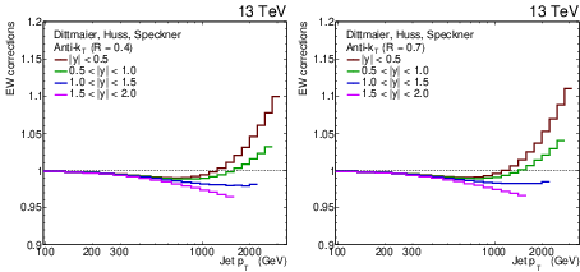
png pdf |
Figure 4:
EW corrections for inclusive jet cross section, as reported in Ref. [52]. The values for jets clustered using the anti-$ {k_{\mathrm {T}}}$ algorithm with $R=$ 0.4 ($R=$ 0.7) are shown on the left (right); each curve corresponds to a rapidity bin. |
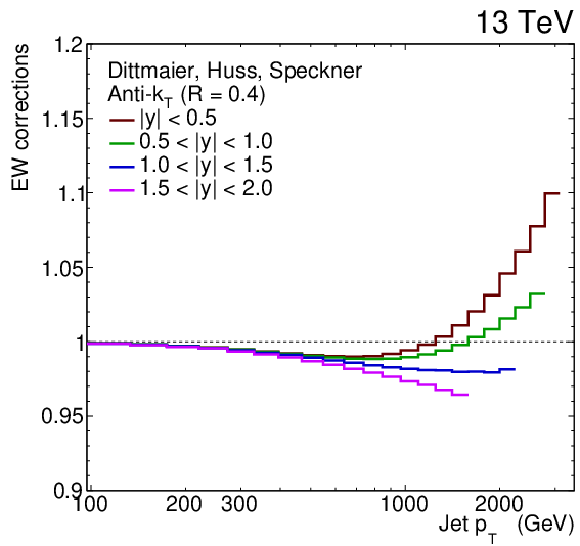
png pdf |
Figure 4-a:
EW corrections for inclusive jet cross section, as reported in Ref. [52]. The values for jets clustered using the anti-$ {k_{\mathrm {T}}}$ algorithm with $R=$ 0.4 are shown; each curve corresponds to a rapidity bin. |

png pdf |
Figure 4-b:
EW corrections for inclusive jet cross section, as reported in Ref. [52]. The values for jets clustered using the anti-$ {k_{\mathrm {T}}}$ algorithm with $R=$ 0.7 are shown; each curve corresponds to a rapidity bin. |

png pdf |
Figure 5:
The values for NP corrections for inclusive jet cross section. The values for jets with $R=$ 0.4 ($R=$ 0.7) are shown on the left (right); each curve corresponds to a rapidity bin. The values correspond to the average of the corrections obtained with PYTHIA 8 and with HERWIG++. |
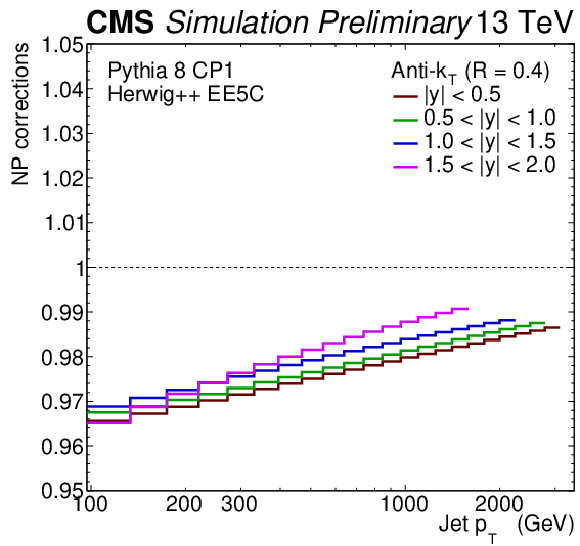
png pdf |
Figure 5-a:
The values for NP corrections for inclusive jet cross section. The values for jets with $R=$ 0.4 are shown; each curve corresponds to a rapidity bin. The values correspond to the average of the corrections obtained with PYTHIA 8 and with HERWIG++. |
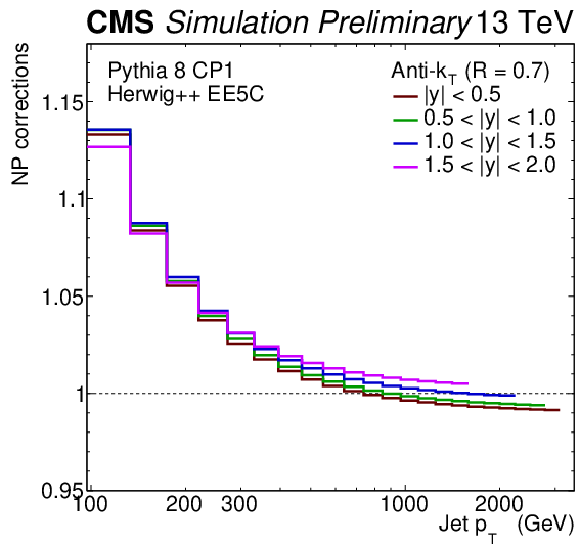
png pdf |
Figure 5-b:
The values for NP corrections for inclusive jet cross section. The values for jets with $R=$ 0.7 are shown; each curve corresponds to a rapidity bin. The values correspond to the average of the corrections obtained with PYTHIA 8 and with HERWIG++. |

png pdf |
Figure 6:
The inclusive jet cross sections double differential in the jet transverse momentum ${p_{\mathrm {T}}}$ and the rapidity $y$. The cross section obtained for jets clustered using the anti-$ {k_{\mathrm {T}}}$ algorithm with $R=$ 0.4 ($R= $ 0.7) are shown on the upper (lower) figure. The different curves correspond to different rapidity intervals and are scaled by a constant factor to avoid overlapping. The data points, shown with markers of different style for the different rapidity bins, are accompanied by the NLO QCD fixed-order predictions based on CT14 PDF, shown with a continuous red line. Only the statistical uncertainties of the data are shown. The predictions are corrected for EW and NP effects. |

png pdf |
Figure 6-a:
The inclusive jet cross sections double differential in the jet transverse momentum ${p_{\mathrm {T}}}$ and the rapidity $y$. The cross section obtained for jets clustered using the anti-$ {k_{\mathrm {T}}}$ algorithm with $R=$ 0.4 are shown. The different curves correspond to different rapidity intervals and are scaled by a constant factor to avoid overlapping. The data points, shown with markers of different style for the different rapidity bins, are accompanied by the NLO QCD fixed-order predictions based on CT14 PDF, shown with a continuous red line. Only the statistical uncertainties of the data are shown. The predictions are corrected for EW and NP effects. |
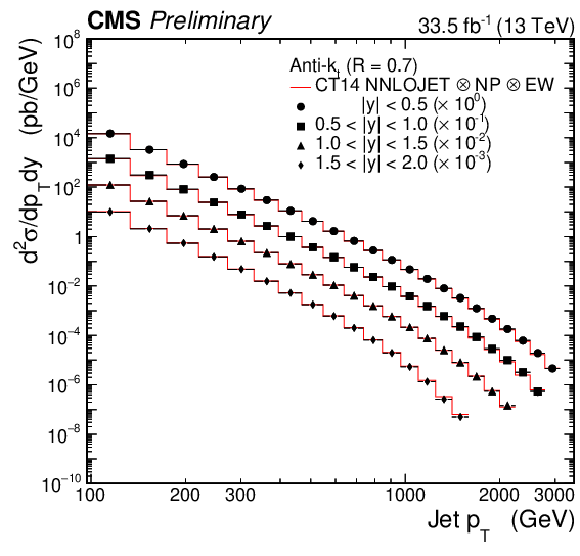
png pdf |
Figure 6-b:
The inclusive jet cross sections double differential in the jet transverse momentum ${p_{\mathrm {T}}}$ and the rapidity $y$. The cross section obtained for jets clustered using the anti-$ {k_{\mathrm {T}}}$ algorithm with $R=$ 0.7 are shown. The different curves correspond to different rapidity intervals and are scaled by a constant factor to avoid overlapping. The data points, shown with markers of different style for the different rapidity bins, are accompanied by the NLO QCD fixed-order predictions based on CT14 PDF, shown with a continuous red line. Only the statistical uncertainties of the data are shown. The predictions are corrected for EW and NP effects. |
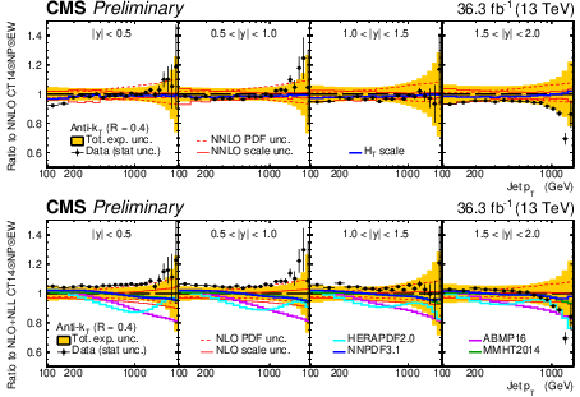
png pdf |
Figure 7:
Double differential cross section as a function of ${p_{\mathrm {T}}}$ and rapidity for jets clustered using the anti-$ {k_{\mathrm {T}}}$ algorithm with $R=$ 0.4. In the top (bottom) figure, all curves are divided by NNLO (NLO+NLL) prediction calculated with CT14 PDF and including NP and EW corrections. The data points are shown with the black markers; alternative predictions to CT14 NLO are shown with thick colour, solid lines. Scale and PDF uncertainties for the same prediction are shown in red lines; total experimental uncertainties are centred at one and shown with the orange band; the error bars on the data points only include the statistical uncertainties from the data. In the top figure, the data is also compared to a similar NNLO prediction with a different scale choice; in the bottom figure, predictions with alternative PDF sets using NLO+NLL predictions are also displayed. |
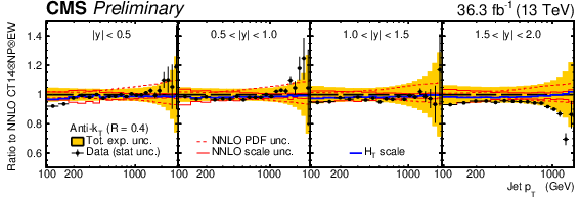
png pdf |
Figure 7-a:
Double differential cross section as a function of ${p_{\mathrm {T}}}$ and rapidity for jets clustered using the anti-$ {k_{\mathrm {T}}}$ algorithm with $R=$ 0.4. All curves are divided by NNLO prediction calculated with CT14 PDF and including NP and EW corrections. The data points are shown with the black markers. Scale and PDF uncertainties for the same prediction are shown in red lines; total experimental uncertainties are centred at one and shown with the orange band; the error bars on the data points only include the statistical uncertainties from the data. The data is also compared to a similar NNLO prediction with a different scale choice. |

png pdf |
Figure 7-b:
Double differential cross section as a function of ${p_{\mathrm {T}}}$ and rapidity for jets clustered using the anti-$ {k_{\mathrm {T}}}$ algorithm with $R=$ 0.4. All curves are divided by NLO+NLL prediction calculated with CT14 PDF and including NP and EW corrections. The data points are shown with the black markers. Scale and PDF uncertainties for the same prediction are shown in red lines; total experimental uncertainties are centred at one and shown with the orange band; the error bars on the data points only include the statistical uncertainties from the data. Predictions with alternative PDF sets using NLO+NLL predictions are also displayed. |

png pdf |
Figure 8:
Double differential cross section as a function of ${p_{\mathrm {T}}}$ and rapidity for jets clustered using the anti-$ {k_{\mathrm {T}}}$ algorithm with $R=$ 0.7. The curves and labels are identical to those of Fig. 7. |

png pdf |
Figure 8-a:
Double differential cross section as a function of ${p_{\mathrm {T}}}$ and rapidity for jets clustered using the anti-$ {k_{\mathrm {T}}}$ algorithm with $R=$ 0.7. The curves and labels are identical to those of Fig. 7-a. |

png pdf |
Figure 8-b:
Double differential cross section as a function of ${p_{\mathrm {T}}}$ and rapidity for jets clustered using the anti-$ {k_{\mathrm {T}}}$ algorithm with $R=$ 0.7. The curves and labels are identical to those of Fig. 7-b. |

png pdf |
Figure 9:
Relative uncertainties in the u-valence (upper left), d-valence (upper right), gluon (lower left), and the singlet (lower right) distributions, shown as a function of $x$ for the scale $\mu _f=m_\mathrm{t} $. The profiling is performed using CT14nlo PDF at NLO, by using inclusive jet cross section at $\sqrt {s} = $ 13 TeV, implying the theory prediction for these data at NLO+NLL. The original uncertainty is shown in red, while the profiled result is shown in blue. |
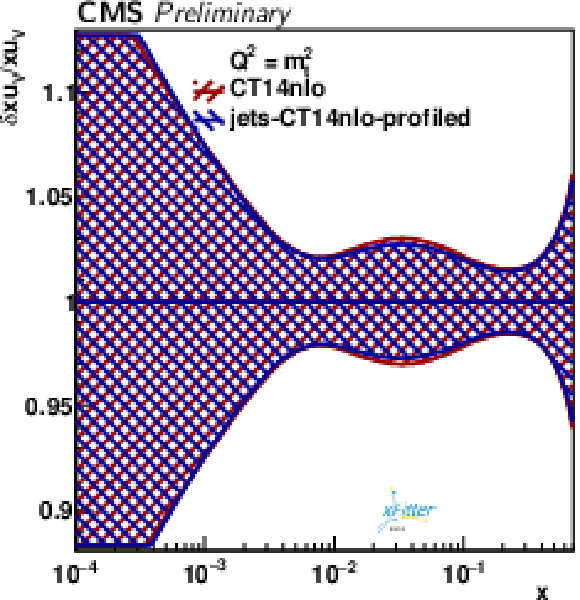
png pdf |
Figure 9-a:
Relative uncertainties in the u-valence distribution, shown as a function of $x$ for the scale $\mu _f=m_\mathrm{t} $. The profiling is performed using CT14nlo PDF at NLO, by using inclusive jet cross section at $\sqrt {s} = $ 13 TeV, implying the theory prediction for these data at NLO+NLL. The original uncertainty is shown in red, while the profiled result is shown in blue. |
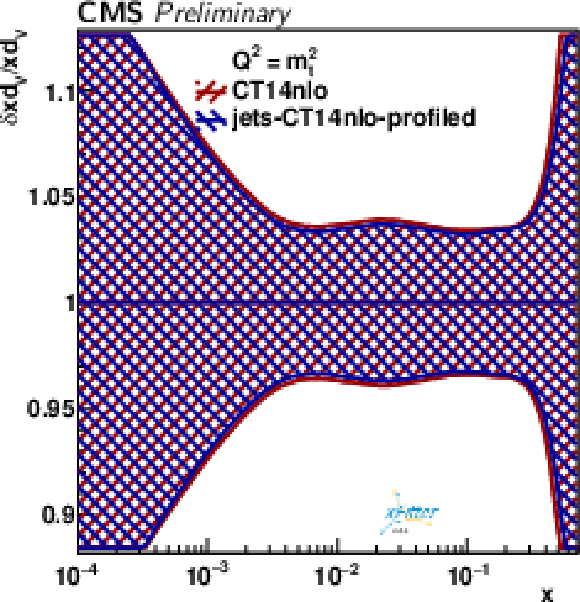
png pdf |
Figure 9-b:
Relative uncertainties in the d-valence distribution, shown as a function of $x$ for the scale $\mu _f=m_\mathrm{t} $. The profiling is performed using CT14nlo PDF at NLO, by using inclusive jet cross section at $\sqrt {s} = $ 13 TeV, implying the theory prediction for these data at NLO+NLL. The original uncertainty is shown in red, while the profiled result is shown in blue. |

png pdf |
Figure 9-c:
Relative uncertainties in the gluon distribution, shown as a function of $x$ for the scale $\mu _f=m_\mathrm{t} $. The profiling is performed using CT14nlo PDF at NLO, by using inclusive jet cross section at $\sqrt {s} = $ 13 TeV, implying the theory prediction for these data at NLO+NLL. The original uncertainty is shown in red, while the profiled result is shown in blue. |

png pdf |
Figure 9-d:
Relative uncertainties in the singlet distribution, shown as a function of $x$ for the scale $\mu _f=m_\mathrm{t} $. The profiling is performed using CT14nlo PDF at NLO, by using inclusive jet cross section at $\sqrt {s} = $ 13 TeV, implying the theory prediction for these data at NLO+NLL. The original uncertainty is shown in red, while the profiled result is shown in blue. |

png pdf |
Figure 10:
Relative uncertainties in the u-valence (upper left), d-valence (upper right), gluon (lower left), and the singlet (lower right) distributions, shown as a function of $x$ for the scale $\mu _f=m_\mathrm{t} $. The profiling is performed using CT14nnlo PDF at NNLO, by using the inclusive jet cross section at $\sqrt {s} = $ 13 TeV, implying the theory prediction for these data at NNLO. The original uncertainty is shown in red, while the profiled result is shown in blue. |

png pdf |
Figure 10-a:
Relative uncertainties in the u-valence distribution, shown as a function of $x$ for the scale $\mu _f=m_\mathrm{t} $. The profiling is performed using CT14nnlo PDF at NNLO, by using the inclusive jet cross section at $\sqrt {s} = $ 13 TeV, implying the theory prediction for these data at NNLO. The original uncertainty is shown in red, while the profiled result is shown in blue. |
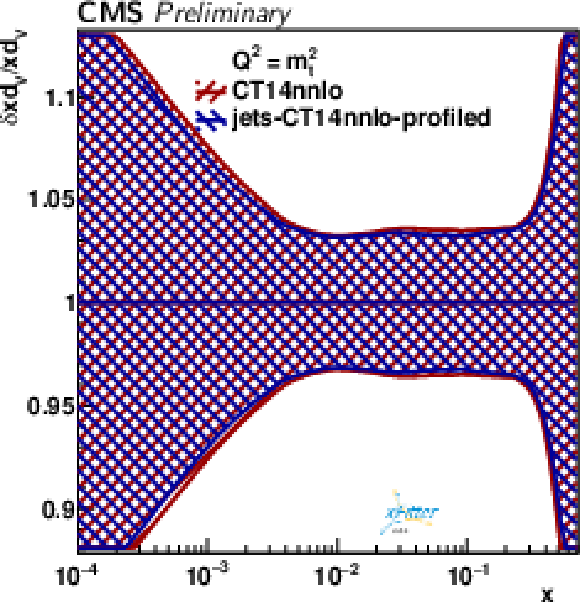
png pdf |
Figure 10-b:
Relative uncertainties in the d-valence distribution, shown as a function of $x$ for the scale $\mu _f=m_\mathrm{t} $. The profiling is performed using CT14nnlo PDF at NNLO, by using the inclusive jet cross section at $\sqrt {s} = $ 13 TeV, implying the theory prediction for these data at NNLO. The original uncertainty is shown in red, while the profiled result is shown in blue. |
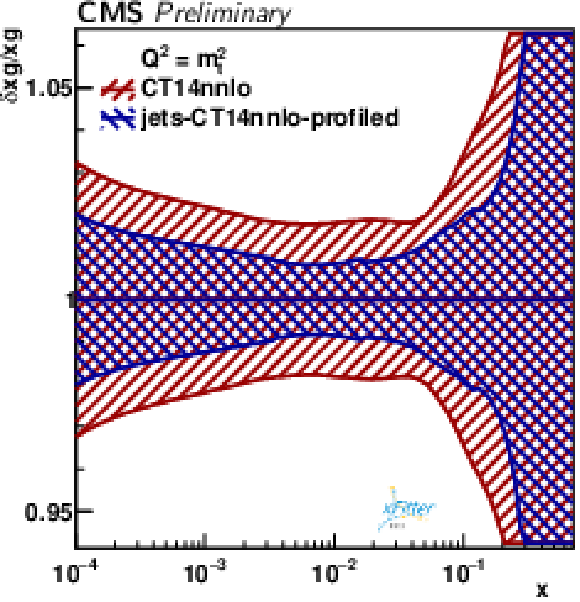
png pdf |
Figure 10-c:
Relative uncertainties in the gluon distribution, shown as a function of $x$ for the scale $\mu _f=m_\mathrm{t} $. The profiling is performed using CT14nnlo PDF at NNLO, by using the inclusive jet cross section at $\sqrt {s} = $ 13 TeV, implying the theory prediction for these data at NNLO. The original uncertainty is shown in red, while the profiled result is shown in blue. |
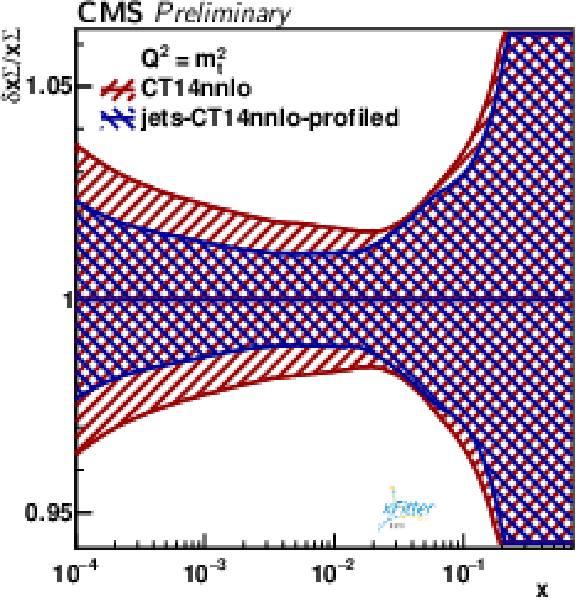
png pdf |
Figure 10-d:
Relative uncertainties in the singlet distribution, shown as a function of $x$ for the scale $\mu _f=m_\mathrm{t} $. The profiling is performed using CT14nnlo PDF at NNLO, by using the inclusive jet cross section at $\sqrt {s} = $ 13 TeV, implying the theory prediction for these data at NNLO. The original uncertainty is shown in red, while the profiled result is shown in blue. |

png pdf |
Figure 11:
The $\chi ^2$ obtained in profiling of CT14 PDF $ {\alpha _\mathrm {S}} (m_{\mathrm{Z}})$ series using the CMS inclusive jet cross sections at $\sqrt {s} = $ 13 TeV at NLO (left) and NNLO (right). |
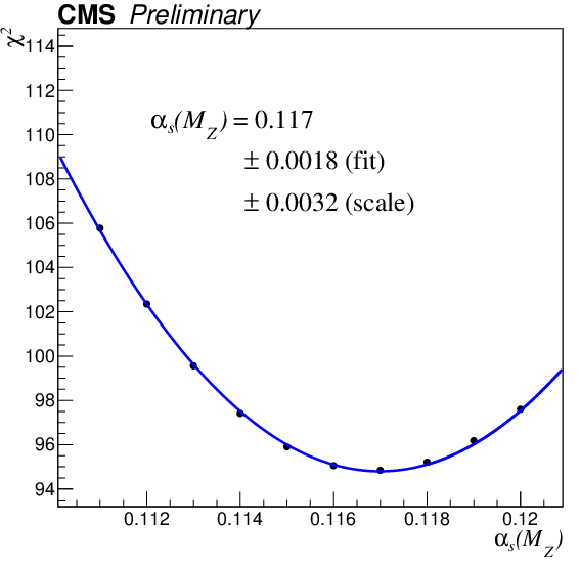
png pdf |
Figure 11-a:
The $\chi ^2$ obtained in profiling of CT14 PDF $ {\alpha _\mathrm {S}} (m_{\mathrm{Z}})$ series using the CMS inclusive jet cross sections at $\sqrt {s} = $ 13 TeV at NLO. |
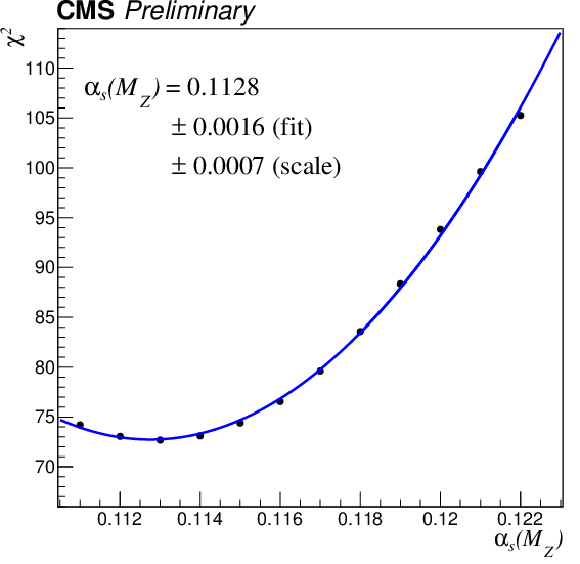
png pdf |
Figure 11-b:
The $\chi ^2$ obtained in profiling of CT14 PDF $ {\alpha _\mathrm {S}} (m_{\mathrm{Z}})$ series using the CMS inclusive jet cross sections at $\sqrt {s} = $ 13 TeV at NNLO. |

png pdf |
Figure 12:
Relative uncertainties in the gluon distribution (left), shown as a function of $x$ for the scale $\mu _f=m_\mathrm{t} $. The profiling is performed using CT14nlo PDF at NLO, by using the CMS inclusive jet cross section and the triple-differential ${\mathrm{t} {}\mathrm{\bar{t}}} $ cross sections at $\sqrt {s} = $ 13 TeV. The original (profiled) uncertainty is shown in red (blue). The $\chi ^2$ (right) obtained in profiling of CT14 PDF $ {\alpha _\mathrm {S}} (M_{\mathrm{Z}})$ series using the same data as in (left). |
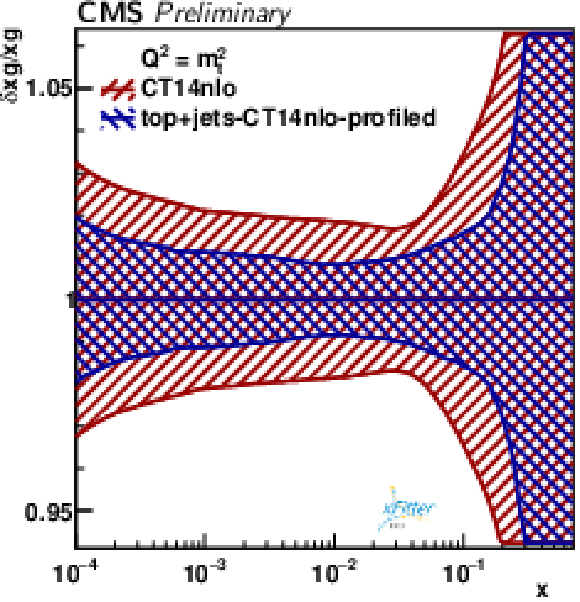
png pdf |
Figure 12-a:
Relative uncertainties in the gluon distribution, shown as a function of $x$ for the scale $\mu _f=m_\mathrm{t} $. The profiling is performed using CT14nlo PDF at NLO, by using the CMS inclusive jet cross section and the triple-differential ${\mathrm{t} {}\mathrm{\bar{t}}} $ cross sections at $\sqrt {s} = $ 13 TeV. The original (profiled) uncertainty is shown in red (blue). |
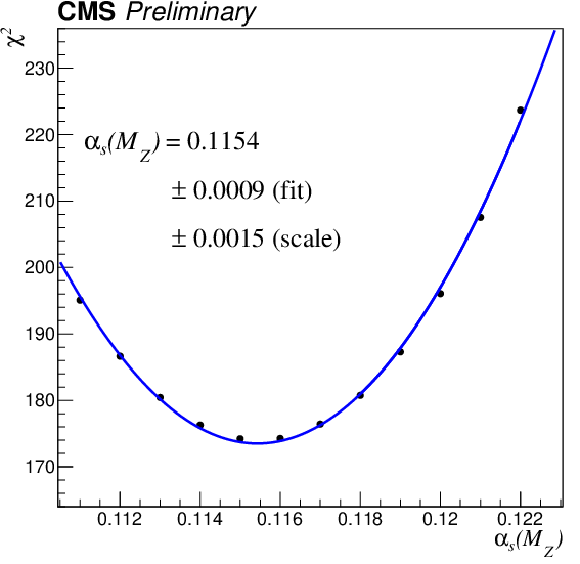
png pdf |
Figure 12-b:
The $\chi ^2$ obtained in profiling of CT14 PDF $ {\alpha _\mathrm {S}} (M_{\mathrm{Z}})$ series using the same data as in Fig. 12-a. |

png pdf |
Figure 13:
The profiled Wilson coefficient $c_1$ for the contact interaction models assuming the left-handed, vector-like, and axial-vector like scenarios, obtained in the profiling analysis at NLO, for the value of $\Lambda = $ 10 TeV. The results are obtained using the CMS inclusive jet cross sections at $\sqrt {s} = $ 13 TeV at NLO and NNLO, and also CMS ${\mathrm{t} {}\mathrm{\bar{t}}} $ triple-differential cross sections. The uncertainties correspond to 68% CL. |
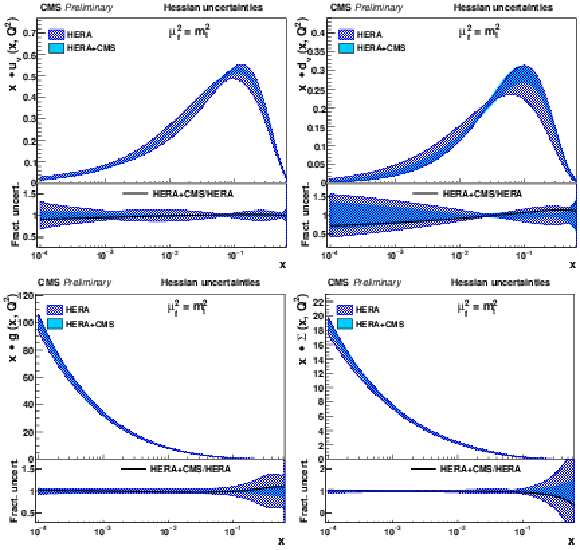
png pdf |
Figure 14:
The u-valence (top left), d-valence (top right), gluon (bottom left), and sea quark (bottom right) distributions shown as a function of $x$ for the starting evolution scale. The filled (hatched) band represents the results of the fit using HERA DIS and the CMS inclusive jet cross sections and the normalized triple-differential cross section of ${\mathrm{t} {}\mathrm{\bar{t}}} $ production at $\sqrt {s} = $ 13 TeV (using the HERA DIS data only). The PDFs are shown with their total uncertainty. In the lower panels, the comparison of the relative PDF uncertainties is shown for each distribution. The dashed line corresponds to the ratio of the central PDF values of the two variants of the fit. |
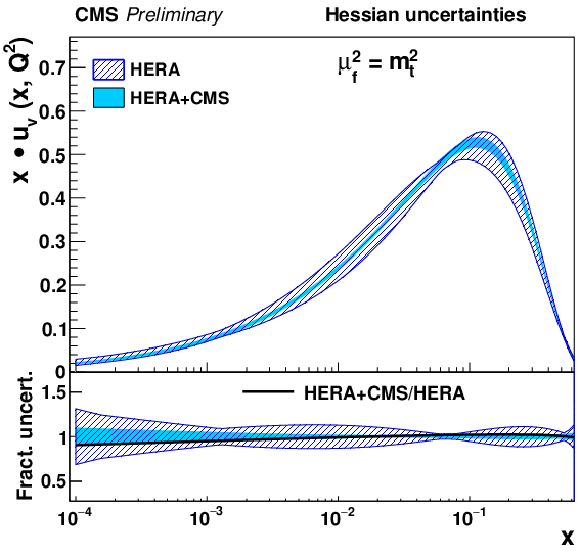
png pdf |
Figure 14-a:
The u-valence distribution shown as a function of $x$ for the starting evolution scale. The filled (hatched) band represents the results of the fit using HERA DIS and the CMS inclusive jet cross sections and the normalized triple-differential cross section of ${\mathrm{t} {}\mathrm{\bar{t}}} $ production at $\sqrt {s} = $ 13 TeV (using the HERA DIS data only). The PDFs are shown with their total uncertainty. In the lower panel, the comparison of the relative PDF uncertainties is shown for each distribution. The dashed line corresponds to the ratio of the central PDF values of the two variants of the fit. |

png pdf |
Figure 14-b:
The d-valence distribution shown as a function of $x$ for the starting evolution scale. The filled (hatched) band represents the results of the fit using HERA DIS and the CMS inclusive jet cross sections and the normalized triple-differential cross section of ${\mathrm{t} {}\mathrm{\bar{t}}} $ production at $\sqrt {s} = $ 13 TeV (using the HERA DIS data only). The PDFs are shown with their total uncertainty. In the lower panel, the comparison of the relative PDF uncertainties is shown for each distribution. The dashed line corresponds to the ratio of the central PDF values of the two variants of the fit. |

png pdf |
Figure 14-c:
The gluon distribution shown as a function of $x$ for the starting evolution scale. The filled (hatched) band represents the results of the fit using HERA DIS and the CMS inclusive jet cross sections and the normalized triple-differential cross section of ${\mathrm{t} {}\mathrm{\bar{t}}} $ production at $\sqrt {s} = $ 13 TeV (using the HERA DIS data only). The PDFs are shown with their total uncertainty. In the lower panel, the comparison of the relative PDF uncertainties is shown for each distribution. The dashed line corresponds to the ratio of the central PDF values of the two variants of the fit. |
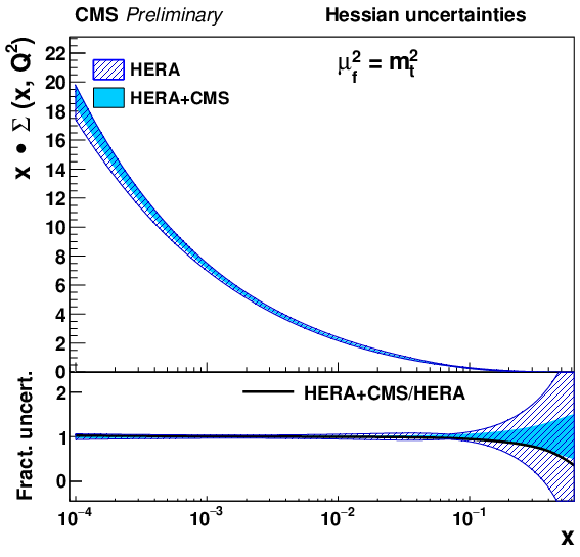
png pdf |
Figure 14-d:
The sea quark distribution shown as a function of $x$ for the starting evolution scale. The filled (hatched) band represents the results of the fit using HERA DIS and the CMS inclusive jet cross sections and the normalized triple-differential cross section of ${\mathrm{t} {}\mathrm{\bar{t}}} $ production at $\sqrt {s} = $ 13 TeV (using the HERA DIS data only). The PDFs are shown with their total uncertainty. In the lower panel, the comparison of the relative PDF uncertainties is shown for each distribution. The dashed line corresponds to the ratio of the central PDF values of the two variants of the fit. |
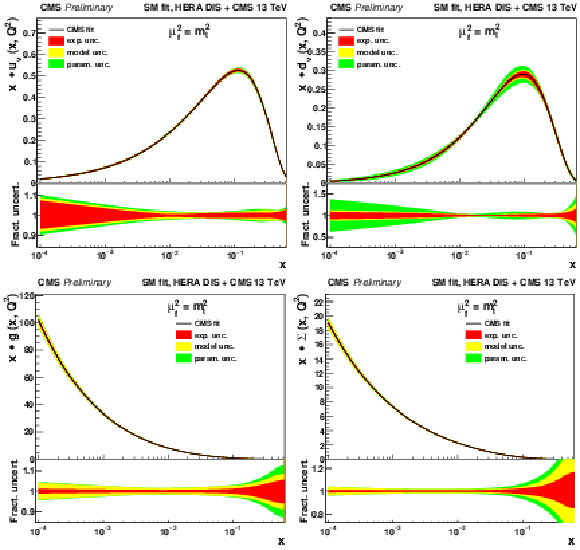
png pdf |
Figure 15:
The u-valence (top left), d-valence (top right), gluon (bottom left), and sea quark (bottom right) distributions shown as a function of $x$ for the starting evolution scale, resulting from the fit using HERA DIS together with the CMS inclusive jet cross sections and the normalized triple-differential cross section of ${\mathrm{t} {}\mathrm{\bar{t}}} $ production at $\sqrt {s} = $ 13 TeV. Contributions of fit, model and parametrisation uncertainties for each PDF are shown. In the lower panels, the relative uncertainty contributions are presented. |
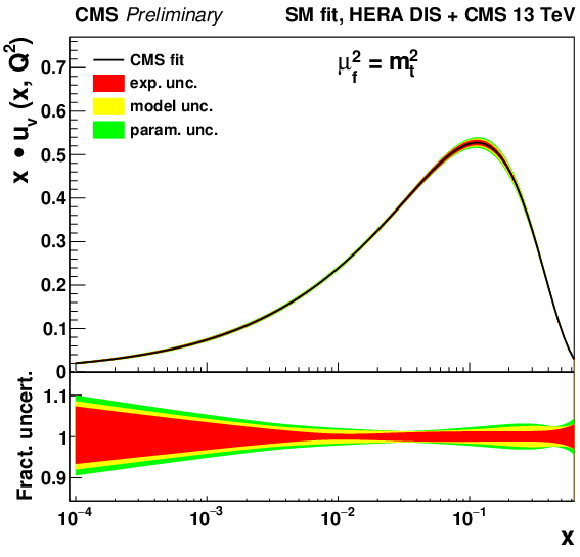
png pdf |
Figure 15-a:
The u-valence distribution shown as a function of $x$ for the starting evolution scale, resulting from the fit using HERA DIS together with the CMS inclusive jet cross sections and the normalized triple-differential cross section of ${\mathrm{t} {}\mathrm{\bar{t}}} $ production at $\sqrt {s} = $ 13 TeV. Contributions of fit, model and parametrisation uncertainties for each PDF are shown. In the lower panel, the relative uncertainty contributions are presented. |

png pdf |
Figure 15-b:
The d-valence distribution shown as a function of $x$ for the starting evolution scale, resulting from the fit using HERA DIS together with the CMS inclusive jet cross sections and the normalized triple-differential cross section of ${\mathrm{t} {}\mathrm{\bar{t}}} $ production at $\sqrt {s} = $ 13 TeV. Contributions of fit, model and parametrisation uncertainties for each PDF are shown. In the lower panel, the relative uncertainty contributions are presented. |
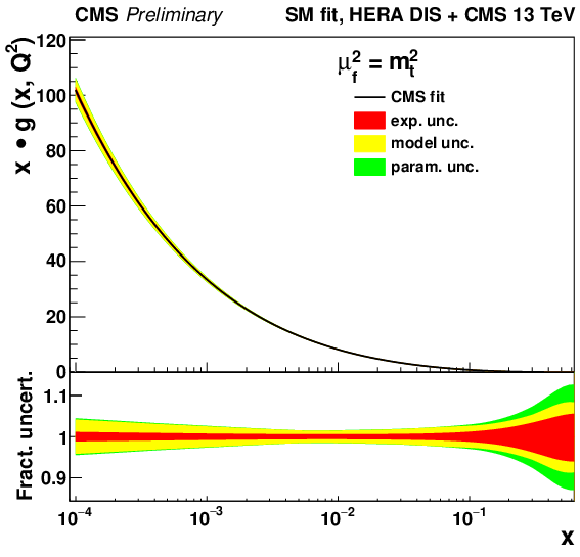
png pdf |
Figure 15-c:
The gluon distribution shown as a function of $x$ for the starting evolution scale, resulting from the fit using HERA DIS together with the CMS inclusive jet cross sections and the normalized triple-differential cross section of ${\mathrm{t} {}\mathrm{\bar{t}}} $ production at $\sqrt {s} = $ 13 TeV. Contributions of fit, model and parametrisation uncertainties for each PDF are shown. In the lower panel, the relative uncertainty contributions are presented. |

png pdf |
Figure 15-d:
The sea quark distribution shown as a function of $x$ for the starting evolution scale, resulting from the fit using HERA DIS together with the CMS inclusive jet cross sections and the normalized triple-differential cross section of ${\mathrm{t} {}\mathrm{\bar{t}}} $ production at $\sqrt {s} = $ 13 TeV. Contributions of fit, model and parametrisation uncertainties for each PDF are shown. In the lower panel, the relative uncertainty contributions are presented. |

png pdf |
Figure 16:
The u-valence (top left), d-valence (top right), gluon (bottom left), and sea quark (bottom right) distributions shown as a function of $x$ for the starting evolution scale, resulting from the SM fit using HERA DIS together with the CMS inclusive jet cross sections and the normalized triple-differential cross section of ${\mathrm{t} {}\mathrm{\bar{t}}} $ production at $\sqrt {s} = $ 13 TeV. Contributions of fit, model, and parametrisation uncertainties for each PDF are shown. In the lower panels, the relative uncertainty contributions are presented. |
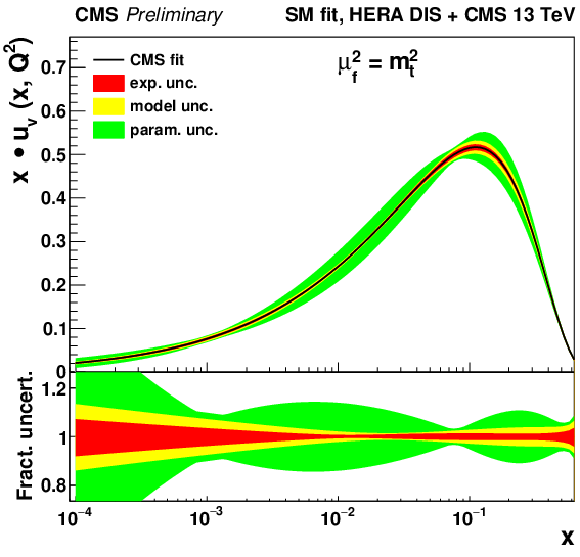
png pdf |
Figure 16-a:
The u-valence distribution shown as a function of $x$ for the starting evolution scale, resulting from the SM fit using HERA DIS together with the CMS inclusive jet cross sections and the normalized triple-differential cross section of ${\mathrm{t} {}\mathrm{\bar{t}}} $ production at $\sqrt {s} = $ 13 TeV. Contributions of fit, model, and parametrisation uncertainties for each PDF are shown. In the lower panel, the relative uncertainty contributions are presented. |

png pdf |
Figure 16-b:
The d-valence distribution shown as a function of $x$ for the starting evolution scale, resulting from the SM fit using HERA DIS together with the CMS inclusive jet cross sections and the normalized triple-differential cross section of ${\mathrm{t} {}\mathrm{\bar{t}}} $ production at $\sqrt {s} = $ 13 TeV. Contributions of fit, model, and parametrisation uncertainties for each PDF are shown. In the lower panel, the relative uncertainty contributions are presented. |
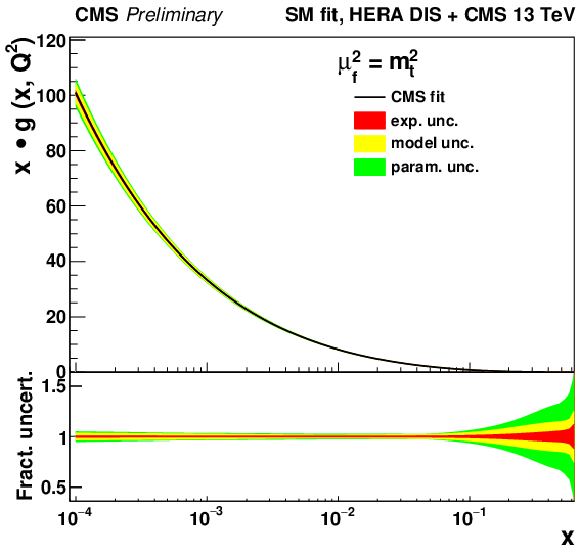
png pdf |
Figure 16-c:
The gluon distribution shown as a function of $x$ for the starting evolution scale, resulting from the SM fit using HERA DIS together with the CMS inclusive jet cross sections and the normalized triple-differential cross section of ${\mathrm{t} {}\mathrm{\bar{t}}} $ production at $\sqrt {s} = $ 13 TeV. Contributions of fit, model, and parametrisation uncertainties for each PDF are shown. In the lower panel, the relative uncertainty contributions are presented. |
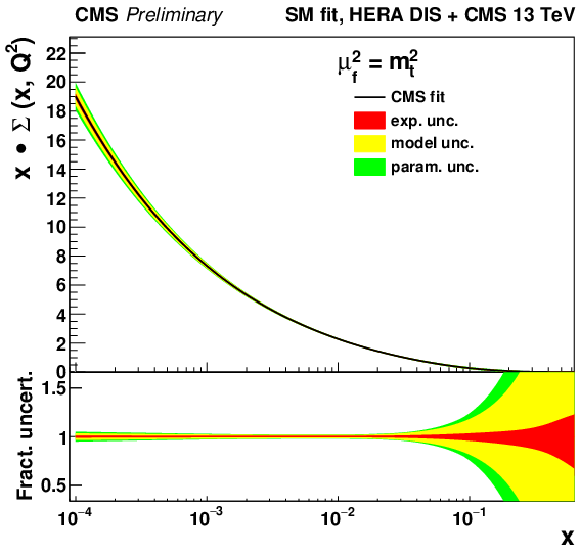
png pdf |
Figure 16-d:
The sea quark distribution shown as a function of $x$ for the starting evolution scale, resulting from the SM fit using HERA DIS together with the CMS inclusive jet cross sections and the normalized triple-differential cross section of ${\mathrm{t} {}\mathrm{\bar{t}}} $ production at $\sqrt {s} = $ 13 TeV. Contributions of fit, model, and parametrisation uncertainties for each PDF are shown. In the lower panel, the relative uncertainty contributions are presented. |

png pdf |
Figure 17:
The u-valence (top left), d-valence (top right), gluon (bottom left), and sea quark (bottom right) distributions shown as a function of $x$ for the starting evolution scale, resulting from the fits with and without the SMEFT CI terms. The SMEFT fit is performed with the left-handed CI model with $\Lambda = $ 10 TeV. |
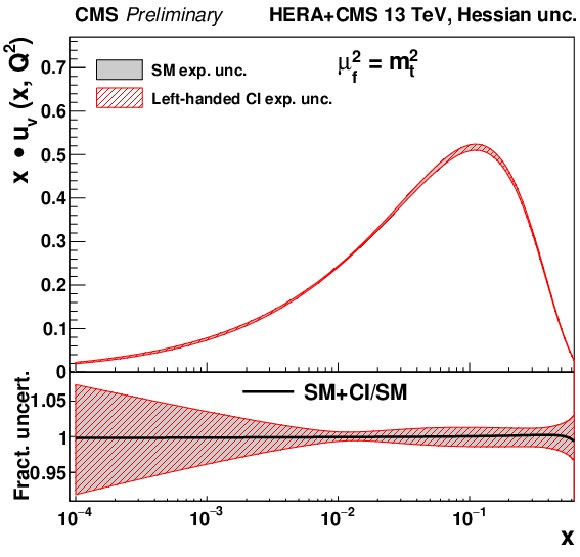
png pdf |
Figure 17-a:
The u-valence distribution shown as a function of $x$ for the starting evolution scale, resulting from the fits with and without the SMEFT CI terms. The SMEFT fit is performed with the left-handed CI model with $\Lambda = $ 10 TeV. |

png pdf |
Figure 17-b:
The d-valence distribution shown as a function of $x$ for the starting evolution scale, resulting from the fits with and without the SMEFT CI terms. The SMEFT fit is performed with the left-handed CI model with $\Lambda = $ 10 TeV. |

png pdf |
Figure 17-c:
The gluon distribution shown as a function of $x$ for the starting evolution scale, resulting from the fits with and without the SMEFT CI terms. The SMEFT fit is performed with the left-handed CI model with $\Lambda = $ 10 TeV. |
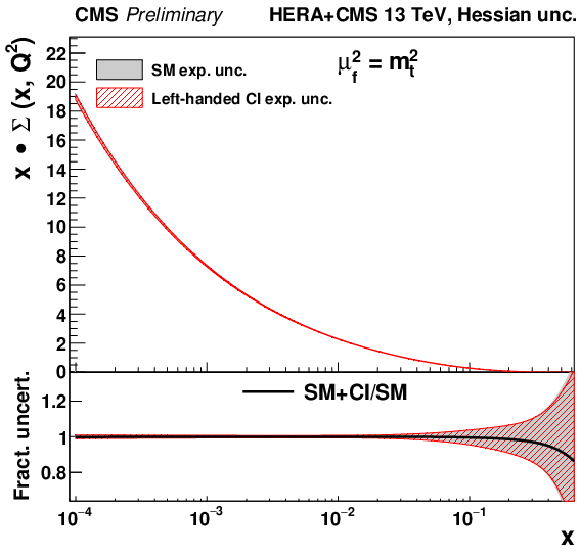
png pdf |
Figure 17-d:
The sea quark distribution shown as a function of $x$ for the starting evolution scale, resulting from the fits with and without the SMEFT CI terms. The SMEFT fit is performed with the left-handed CI model with $\Lambda = $ 10 TeV. |

png pdf |
Figure 18:
The u-valence (top left), d-valence (top right), gluon (bottom left), and sea quark (bottom right) distributions shown as a function of $x$ for the starting evolution scale, resulting from the SMEFT fit with the left-handed CI model with $\Lambda = $ 10 TeV. The PDFs are shown with the fit uncertainties obtained by the Hessian (blue) and Monte Carlo (red) methods. |
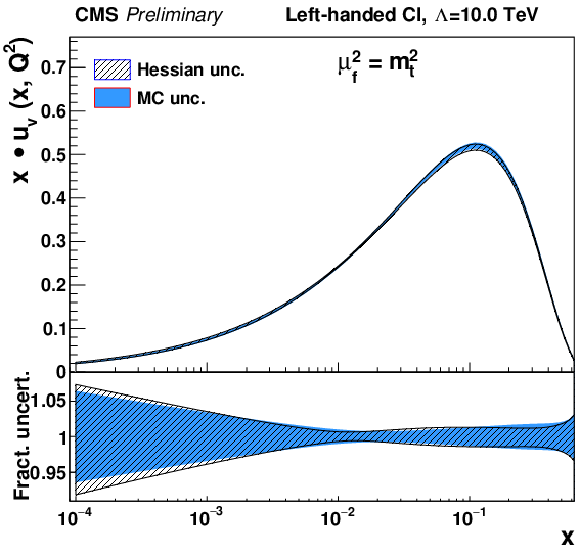
png pdf |
Figure 18-a:
The u-valence distribution shown as a function of $x$ for the starting evolution scale, resulting from the SMEFT fit with the left-handed CI model with $\Lambda = $ 10 TeV. The PDFs are shown with the fit uncertainties obtained by the Hessian (blue) and Monte Carlo (red) methods. |

png pdf |
Figure 18-b:
The d-valence distribution shown as a function of $x$ for the starting evolution scale, resulting from the SMEFT fit with the left-handed CI model with $\Lambda = $ 10 TeV. The PDFs are shown with the fit uncertainties obtained by the Hessian (blue) and Monte Carlo (red) methods. |
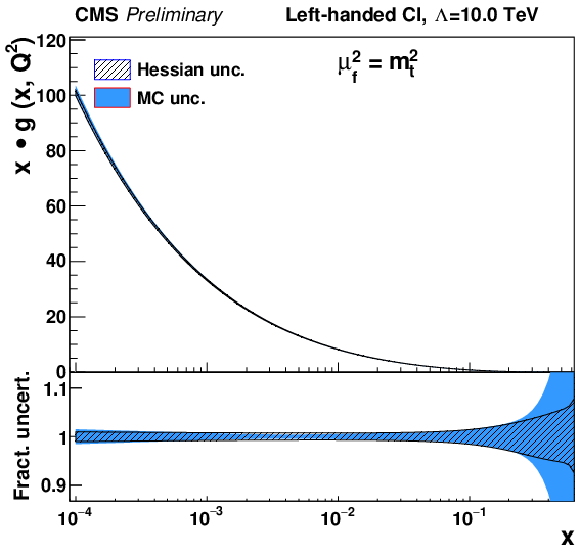
png pdf |
Figure 18-c:
The gluon distribution shown as a function of $x$ for the starting evolution scale, resulting from the SMEFT fit with the left-handed CI model with $\Lambda = $ 10 TeV. The PDFs are shown with the fit uncertainties obtained by the Hessian (blue) and Monte Carlo (red) methods. |

png pdf |
Figure 18-d:
The sea quark distribution shown as a function of $x$ for the starting evolution scale, resulting from the SMEFT fit with the left-handed CI model with $\Lambda = $ 10 TeV. The PDFs are shown with the fit uncertainties obtained by the Hessian (blue) and Monte Carlo (red) methods. |
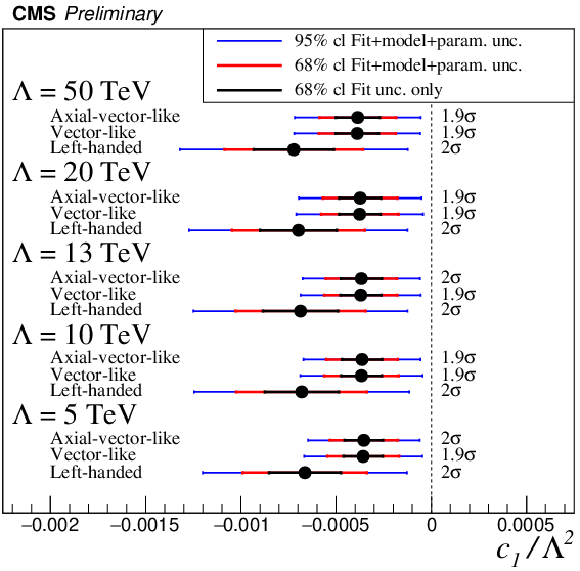
png pdf |
Figure 19:
The fitted Wilson coefficients $c_1$ divided by the scale $\Lambda ^2$ of the respective fit. The experimental uncertainties are shown at 68% CL (black). The full uncertainties including model and parameterisation uncertainties are given at 68% CL (red) and 95% CL (blue). The significance of the difference from zero is written to the right of each point, indicating that the results are consistent with the SM. |
| Tables | |

png pdf |
Table 1:
Recent measurements of inclusive jet production, performed by the ATLAS and CMS collaborations at different centre-of-mass energies with the corresponding integrated luminosities. |

png pdf |
Table 2:
Description of the simulated samples used in the analysis. |

png pdf |
Table 3:
HLT trigger ranges and effective integrated luminosities used in the jet cross section measurement for $R=$ 0.4. The first (second) row shows the ${p_{\mathrm {T}}}$ threshold for the HLT (PF) reconstruction; the third row corresponds to the effective luminosity of each trigger. |

png pdf |
Table 4:
HLT trigger ranges and effective integrated luminosities used in the jet cross section measurement for $R=$ 0.7. The first (second) row shows the ${p_{\mathrm {T}}}$ threshold for the HLT (PF) reconstruction; the third row corresponds to the effective luminosity of each trigger. |

png pdf |
Table 5:
The relations imposed between the Wilson coefficients in the three CI models studied herein. |
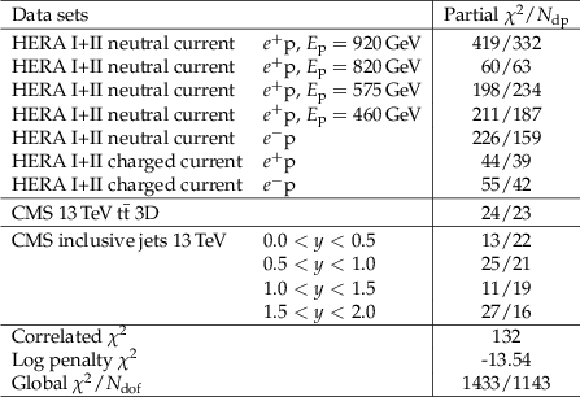
png pdf |
Table 6:
Partial $\chi ^2/N_{\textrm {dp}}$ values obtained in the QCD analysis of HERA DIS data and CMS data for 13 TeV $R=$ 0.7 inclusive jet production and 13 TeV ${\mathrm{t} {}\mathrm{\bar{t}}} $ triple-differential cross-section data. $N_{\textrm {dp}}$ is the amount of data points and $N_{\textrm {dof}}$ the number of degrees of freedom. In the DIS data, the proton beam energy is given as $E_{\textrm {p}}$ and the electron energy is 27.5 GeV. |
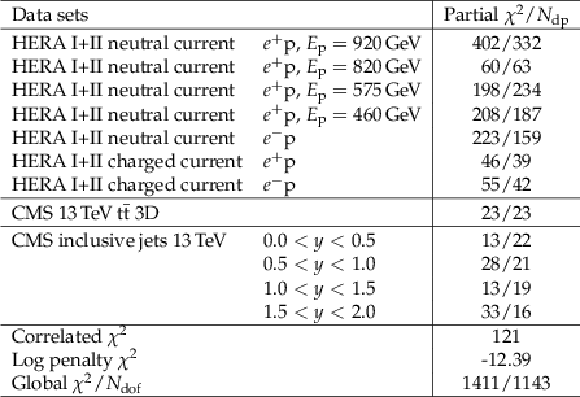
png pdf |
Table 7:
Partial $\chi ^2$ per number of data points $N_{dp}$ and the global $\chi ^2$ per degree of freedom, $N_{dof}$, as obtained in the QCD analysis of HERA DIS data and the CMS measurements of inclusive jet production and the normalized triple-differential ${\mathrm{t} {}\mathrm{\bar{t}}} $ production at $\sqrt {s} = $ 13 TeV. |

png pdf |
Table 8:
The values and uncertainties of the fitted Wilson coefficients $c_1$ for various scales $\Lambda $. The fit uncertainties are obtained by using the Hessian method. |
| Summary |
|
In this note, a measurement of the double differential inclusive jet cross section is presented as a function of the jet transverse momentum ${p_{\mathrm{T}}}$ and rapidity $|y|$ for jets reconstructed using the anti-${k_{\mathrm{T}}}$ clustering algorithm with a size parameter of $0.4$ and $0.7$. The phase space covers jet ${p_{\mathrm{T}}}$ from 97 GeV up to 3.1 TeV and jet rapidity up to $|y|=$ 2.0. The measured jet cross section is compared to the predictions of perturbative QCD at next-to-leading order, next-to-next-to-leading order and next-to-leading order with next-to-leading logarithm resummation correction, using various sets of parton distribution functions. Strong sensitivity of the measurement to the parton distributions is observed. In order to investigate the impact of the measurements on the parton distribution functions and the strong coupling, a QCD analysis is performed, where the jet cross sections are used together with the HERA DIS measurements and with the CMS measurement of the triple-differential top quark-antiquark production cross sections. In addition to the parton distributions in the proton, the value of the strong coupling, and the mass of the top quark are also extracted. The resulting significant improvement of the accuracy of the parton distributions is demonstrated for the CT14 PDF set in a profiling study and in a full QCD fit. The resulting values of the strong coupling constant agree with the world average and the previous CMS results using the jet measurements. The obtained value of the top quark mass agrees well with the result of the previous CMS analysis using the triple-differential cross sections of the top quark pair production. Although the inclusive jet production is not directly sensitive to the value of the top quark mass, the resulting value profits from the additional constraint on the gluon distribution and on the strong coupling constant provided by the jet measurements. Furthermore, an alternative QCD analysis is performed with the same data, where the standard model Lagrangian is modified by the introduction of effective terms related to quark contact interactions. In the analysis, the Wilson coefficients for the contact interactions are extracted for different values of the scale of the new interaction. This approach has the advantage of an indirect search for new physics with the simultaneous extraction of parameters of the standard model, thereby reducing possible bias in the BSM interpretation of the data. The results are compatible with the standard model and the previous results obtained at the LHC using the jet production. |
| References | ||||
| 1 | ATLAS Collaboration | Measurement of Inclusive Jet and Dijet Cross Sections in Proton-Proton Collisions at 7 TeV Centre-of-Mass Energy with the ATLAS Detector | EPJC 71 (2011) 1512 | 1009.5908 |
| 2 | ATLAS Collaboration | Measurement of inclusive jet and dijet production in pp collisions at $ \sqrt{s}= $ 7 TeV using the ATLAS detector | PRD 86 (2012) 014022 | 1112.6297 |
| 3 | CMS Collaboration | Measurement of the Inclusive Jet Cross Section in pp Collisions at $ \sqrt{s}= $ 7 TeV | PRL 107 (2011) 132001 | CMS-QCD-10-011 1106.0208 |
| 4 | CMS Collaboration | Measurement of the double-differential inclusive jet cross section in proton-proton collisions at $ \sqrt{s} = $ 13 TeV | EPJC 76 (2016) 451 | CMS-SMP-15-007 1605.04436 |
| 5 | ATLAS Collaboration | Measurement of the inclusive jet cross section in pp collisions at $\sqrt(s)=$2.76 TeV and comparison to the inclusive jet cross section at $\sqrt(s)=$7 TeV using the ATLAS detector | EPJC 73 (2013) 2509 | 1304.4739 |
| 6 | CMS Collaboration | Measurement of the inclusive jet cross section in pp collisions at $ \sqrt{s} = $ 2.76 TeV | EPJC 76 (2016) 265 | CMS-SMP-14-017 1512.06212 |
| 7 | ATLAS Collaboration | Measurement of the inclusive jet cross-section in proton-proton collisions at $ \sqrt{s}= $ 7 TeV using 4.5 fb$ ^{-1} $ of data with the ATLAS detector | JHEP 02 (2015) 153 | 1410.8857 |
| 8 | CMS Collaboration | Measurements of differential jet cross sections in proton-proton collisions at $ \sqrt{s}= $ 7 tev with the CMS detector | PRD 87 (2013) 112002 | CMS-QCD-11-004 1212.6660 |
| 9 | CMS Collaboration | Measurement of the Ratio of Inclusive Jet Cross Sections using the Anti-$ k_T $ Algorithm with Radius Parameters R=0.5 and 0.7 in pp Collisions at $ \sqrt{s}= $ 7 TeV | PRD 90 (2014) 072006 | CMS-SMP-13-002 1406.0324 |
| 10 | ATLAS Collaboration | Measurement of the inclusive jet cross-sections in proton-proton collisions at $ \sqrt{s}= $ 8 TeV with the ATLAS detector | JHEP 09 (2017) 020 | 1706.03192 |
| 11 | CMS Collaboration | Measurement and QCD analysis of double-differential inclusive jet cross sections in pp collisions at $ \sqrt{s}= $ 8 TeV and cross section ratios to 2.76 and 7 TeV | JHEP 03 (2017) 156 | CMS-SMP-14-001 1609.05331 |
| 12 | ATLAS Collaboration | Measurement of inclusive jet and dijet cross-sections in proton-proton collisions at $ \sqrt{s}= $ 13 TeV with the ATLAS detector | JHEP 05 (2018) 195 | 1711.02692 |
| 13 | J. Currie, E. W. N. Glover, and J. Pires | Next-to-Next-to Leading Order QCD Predictions for Single Jet Inclusive Production at the LHC | PRL 118 (2017) 072002 | 1611.01460 |
| 14 | J. Currie et al. | Single Jet Inclusive Production for the Individual Jet $ p_{\rm T} $ Scale Choice at the LHC | Acta Phys. Polon. B 48 (2017) 955 | 1704.00923 |
| 15 | J. Currie et al. | Infrared sensitivity of single jet inclusive production at hadron colliders | JHEP 10 (2018) 155 | 1807.03692 |
| 16 | M. Cacciari, G. P. Salam, and G. Soyez | The anti-$ k_t $ jet clustering algorithm | JHEP 04 (2008) 063 | 0802.1189 |
| 17 | M. Cacciari, G. P. Salam, and G. Soyez | FastJet User Manual | EPJC 72 (2012) 1896 | 1111.6097 |
| 18 | M. Dasgupta, L. Magnea, and G. P. Salam | Non-perturbative QCD effects in jets at hadron colliders | JHEP 02 (2008) 055 | 0712.3014 |
| 19 | CMS Collaboration | Dependence of inclusive jet production on the anti-k$ _{T} $ distance parameter in pp collisions at $ \sqrt{\mathrm{s}} = $ 13 TeV | JHEP 12 (2020) 082 | CMS-SMP-19-003 2005.05159 |
| 20 | CMS Collaboration | Constraints on parton distribution functions and extraction of the strong coupling constant from the inclusive jet cross section in pp collisions at $ \sqrt{s} = $ 7 TeV | EPJC 75 (2015) 288 | CMS-SMP-12-028 1410.6765 |
| 21 | H1, ZEUS Collaboration | Combination of measurements of inclusive deep inelastic $ {e^{\pm}p} $ scattering cross sections and QCD analysis of HERA data | EPJC 75 (2015) 580 | 1506.06042 |
| 22 | CMS Collaboration | Measurement of $ \mathrm{t\bar t} $ normalised multi-differential cross sections in pp collisions at $ \sqrt s= $ 13 TeV, and simultaneous determination of the strong coupling strength, top quark pole mass, and parton distribution functions | EPJC 80 (2020) 658 | CMS-TOP-18-004 1904.05237 |
| 23 | CMS Collaboration | Search for Contact Interactions Using the Inclusive Jet $ p_T $ Spectrum in pp Collisions at $ \sqrt{s} = $ 7 TeV | PRD 87 (2013) 052017 | CMS-EXO-11-010 1301.5023 |
| 24 | CMS Collaboration | Search for quark compositeness in dijet angular distributions from pp collisions at $ \sqrt{s} = $ 7 TeV | JHEP 05 (2012) 055 | |
| 25 | CMS Collaboration | Particle-flow reconstruction and global event description with the cms detector | JINST 12 (2017) P10003 | CMS-PRF-14-001 1706.04965 |
| 26 | CMS Collaboration | Jet energy scale and resolution in the CMS experiment in pp collisions at 8 TeV | JINST 12 (2017) P02014 | CMS-JME-13-004 1607.03663 |
| 27 | CMS Collaboration | Performance of missing transverse momentum reconstruction in proton-proton collisions at $ \sqrt{s} = $ 13 TeV using the CMS detector | JINST 14 (2019) P07004 | CMS-JME-17-001 1903.06078 |
| 28 | CMS Collaboration | The CMS trigger system | JINST 12 (2017) P01020 | CMS-TRG-12-001 1609.02366 |
| 29 | CMS Collaboration | The CMS experiment at the CERN LHC | JINST 3 (2008) S08004 | CMS-00-001 |
| 30 | T. Sjostrand, S. Mrenna, and P. Skands | PYTHIA 6.4 physics and manual | JHEP 05 (2006) 026 | hep-ph/0603175 |
| 31 | T. Sjostrand et al. | An introduction to PYTHIA 8.2 | CPC 191 (2015) 159 | 1410.3012 |
| 32 | T. Sjostrand, S. Mrenna, and P. Skands | A brief introduction to pythia 8.1 | CPC 178 (2008) 852 | |
| 33 | R. D. Ball et al. | Parton distributions with LHC data | NPB 867 (2013) 244 | 1207.1303 |
| 34 | CMS Collaboration | Event generator tunes obtained from underlying event and multiparton scattering measurements | EPJC 76 (2016) 155 | CMS-GEN-14-001 1512.00815 |
| 35 | J. Alwall et al. | MadGraph 5 : going beyond | JHEP 06 (2011) 128 | 1106.0522 |
| 36 | J. Alwall et al. | The automated computation of tree-level and next-to-leading order differential cross sections, and their matching to parton shower simulations | JHEP 07 (2014) 079 | 1405.0301 |
| 37 | M. Bahr et al. | Herwig++ physics and manual | EPJC 58 (2008) 639 | 0803.0883 |
| 38 | J. Pumplin et al. | New generation of parton distributions with uncertainties from global QCD analysis | JHEP 07 (2002) 012 | hep-ph/0201195 |
| 39 | J. Gaiser | Charmonium Spectroscopy From Radiative Decays of the $\mathrm{J}/\psi$ | PhD thesis, SLAC | |
| 40 | S. Schmitt | TUnfold, an algorithm for correcting migration effects in high energy physics | JINST 7 (oct, 2012) T10003 | |
| 41 | CMS Collaboration | Precision luminosity measurement in proton-proton collisions at $ \sqrt{s} = $ 13 TeV in 2015 and 2016 at CMS | 2021. Submitted to EPJC | CMS-LUM-17-003 2104.01927 |
| 42 | T. Gehrmann et al. | Jet cross sections and transverse momentum distributions with NNLOJET | PoS RADCOR2017 (2018) 074 | 1801.06415 |
| 43 | T. Kluge, K. Rabbertz, and M. Wobisch | FastNLO: Fast pQCD calculations for PDF fits | in Deep inelastic scattering. Proceedings, 14th International Workshop, DIS 2006, Tsukuba, Japan, 2006 | hep-ph/0609285 |
| 44 | fastNLO Collaboration | Theory-Data Comparisons for Jet Measurements in Hadron-Induced Processes | 2011 | 1109.1310 |
| 45 | fastNLO Collaboration, D. Britzger, K. Rabbertz, F. Stober, and M. Wobisch | New features in version 2 of the fastNLO project | in Proceedings, 20th International Workshop on Deep-Inelastic Scattering and Related Subjects (DIS 2012), Bonn, Germany, 2012 | 1208.3641 |
| 46 | S. Dulat et al. | New parton distribution functions from a global analysis of quantum chromodynamics | PRD 93 (2016) 033006 | 1506.07443 |
| 47 | NNPDF Collaboration | Parton distributions from high-precision collider data | EPJC 77 (2017) 663 | 1706.00428 |
| 48 | L. A. Harland-Lang, A. D. Martin, P. Motylinski, and R. S. Thorne | Parton distributions in the LHC era: MMHT 2014 PDFs | EPJC 75 (2015) 204 | 1412.3989 |
| 49 | S. Alekhin, J. Blumlein, S. Moch, and R. Placakyte | Parton distribution functions, $ \alpha_s $, and heavy-quark masses for LHC Run II | PRD 96 (2017) 014011 | 1701.05838 |
| 50 | X. Liu, S.-O. Moch, and F. Ringer | Phenomenology of single-inclusive jet production with jet radius and threshold resummation | PRD 97 (2018) 056026 | 1801.07284 |
| 51 | J. Gao et al. | MEKS: a program for computation of inclusive jet cross sections at hadron colliders | CPC 184 (2013) 1626 | 1207.0513 |
| 52 | S. Dittmaier, A. Huss, and C. Speckner | Weak radiative corrections to dijet production at hadron colliders | JHEP 11 (2012) 095 | 1210.0438 |
| 53 | CMS Collaboration | Extraction and validation of a new set of CMS PYTHIA8 tunes from underlying-event measurements | EPJC 80 (2020) 4 | CMS-GEN-17-001 1903.12179 |
| 54 | xFitter Developers' Team Collaboration | xFitter 2.0.0: An Open Source QCD Fit Framework | PoS DIS2017 (2018) 203 | 1709.01151 |
| 55 | S. Alekhin et al. | HERAFitter | EPJC 75 (2015) 304 | 1410.4412 |
| 56 | V. N. Gribov and L. N. Lipatov | Deep inelastic e p scattering in perturbation theory | Sov. J. NP 15 (1972) 438 | |
| 57 | G. Altarelli and G. Parisi | Asymptotic freedom in parton language | NPB 126 (1977) 298 | |
| 58 | G. Curci, W. Furmanski, and R. Petronzio | Evolution of parton densities beyond leading order: The non-singlet case | NPB 175 (1980) 27 | |
| 59 | W. Furmanski and R. Petronzio | Singlet parton densities beyond leading order | PLB 97 (1980) 437 | |
| 60 | S. Moch, J. A. M. Vermaseren, and A. Vogt | The Three loop splitting functions in QCD: The Nonsinglet case | NPB 688 (2004) 101 | hep-ph/0403192 |
| 61 | A. Vogt, S. Moch, and J. A. M. Vermaseren | The Three-loop splitting functions in QCD: The Singlet case | NPB 691 (2004) 129 | hep-ph/0404111 |
| 62 | M. Botje | QCDNUM: Fast QCD Evolution and Convolution | CPC 182 (2011) 490 | 1005.1481 |
| 63 | D. Britzger et al. | Calculations for deep inelastic scattering using fast interpolation grid techniques at NNLO in QCD and the extraction of $ \alpha_s $ from HERA data | EPJC 79 (2019) 845 | 1906.05303 |
| 64 | R. S. Thorne and R. G. Roberts | An Ordered analysis of heavy flavor production in deep inelastic scattering | PRD 57 (1998) 6871 | hep-ph/9709442 |
| 65 | R. S. Thorne | A Variable-flavor number scheme for NNLO | PRD 73 (2006) 054019 | hep-ph/0601245 |
| 66 | R. S. Thorne | Effect of changes of variable flavor number scheme on parton distribution functions and predicted cross sections | PRD 86 (2012) 074017 | 1201.6180 |
| 67 | J. Gao, C. S. Li, and C. P. Yuan | NLO QCD Corrections to dijet Production via Quark Contact Interactions | JHEP 07 (2012) 037 | 1204.4773 |
| 68 | J. Gao | CIJET: A program for computation of jet cross sections induced by quark contact interactions at hadron colliders | CPC 184 (2013) 2362 | 1301.7263 |
| 69 | L. Randall and R. Sundrum | Large mass hierarchy from a small extra dimension | PRL 83 (Oct, 1999) 3370 | |
| 70 | P. Langacker | The Physics of Heavy $ Z^\prime $ Gauge Bosons | Rev. Mod. Phys. 81 (2009) 1199 | 0801.1345 |
| 71 | H. Paukkunen and P. Zurita | PDF reweighting in the Hessian matrix approach | JHEP 12 (2014) 100 | 1402.6623 |
| 72 | xFitter developers | xFitter PDF fitting package manual | link | |
| 73 | J. Pumplin et al. | Uncertainties of predictions from parton distribution functions. 2. The Hessian method | PRD 65 (2001) 014013 | hep-ph/0101032 |
| 74 | W. T. Giele and S. Keller | Implications of hadron collider observables on parton distribution function uncertainties | PRD 58 (1998) 094023 | hep-ph/9803393 |
| 75 | W. T. Giele, S. A. Keller, and D. A. Kosower | Parton Distribution Function Uncertainties | hep-ph/0104052 | |
| 76 | Particle Data Group Collaboration | Review of Particle Physics | PTEP 2020 (2020) 083C01 | |
| 77 | H1 Collaboration | Determination of the strong coupling constant $ \alpha_s(m_Z) $ in next-to-next-to-leading order QCD using H1 jet cross section measurements | EPJC 77 (2017) 791 | 1709.07251 |
| 78 | CMS Collaboration | Measurement of the $ \mathrm{t}\overline{\mathrm{t}} $ production cross section, the top quark mass, and the strong coupling constant using dilepton events in pp collisions at $ \sqrt{s} = $ 13 TeV | EPJC 79 (2019) 368 | CMS-TOP-17-001 1812.10505 |
| 79 | ATLAS Collaboration | Search for new phenomena in dijet events using 37 fb $ ^{-1} $ of pp collision data collected at $ \sqrt{s}= $ 13 TeV with the ATLAS detector | PRD 96 (2017) 052004 | 1703.09127 |

|
Compact Muon Solenoid LHC, CERN |

|

|

|

|

|

|